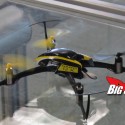Raging Rotors: The Path to Pilot is Paved in Broken Blades and Landing Skids, Part 2: Pucker Up, Buttercup!
 As we move forward in the journey to be a pilot, I cannot help but reminisce when I first started stepping up my piloting game by buying a collective pitch (or 3D Stunt) helicopter, the Blade Nano CPx. I was so excited, until I took it out of the box and got it ready for flight. That one ounce micro helicopter couldn’t have scared me more even if it was spined like a cactus! Why was I scared, you ask? I was freaked because I was about to fly $150!! With my penny pinching habits, I couldn’t help but tighten up, or pucker, when I started flying.
As we move forward in the journey to be a pilot, I cannot help but reminisce when I first started stepping up my piloting game by buying a collective pitch (or 3D Stunt) helicopter, the Blade Nano CPx. I was so excited, until I took it out of the box and got it ready for flight. That one ounce micro helicopter couldn’t have scared me more even if it was spined like a cactus! Why was I scared, you ask? I was freaked because I was about to fly $150!! With my penny pinching habits, I couldn’t help but tighten up, or pucker, when I started flying.
What I wanted to focus on this week is stuff breaks. I know that being an avid reader of BigSquid usually comes with an understanding of this fundamental concept, but take it from me, it still is no easy task. Helicopters and planes break, wear, and tear and there is nothing that can stop that. With that being said, this is where your local hobby shop can be of assistance. When you are looking for your RC helicopter (or plane), ask for advice! Tell them what you’re looking to do and what environment you want to do it in, and they will give you a heap of advice. In my time flying, I have seen customers (now friends) grow from a coaxial (double bladed) indoor helicopter to flying stunt helicopters at events like eFest in Champaign. Don’t forget to ask about breakable parts on the aircraft you end up choosing; most the time the person you talk to can easily hand you a few parts he/she knows will help you save a trip back later (at least the first time).
Personally, I offer a few suggestions for your first RC aircraft. For you RC Helicopter enthusiasts, if you want a docile scale looking indoor flyer you’re looking at something like a Blade MCx/MCx2 or an Ares MD500 D 100CX. Both of these offer stable flight in zero wind conditions and also have the look of full size helicopters. If a scale look does not matter and you would like to be able to fly indoors and out, I definitely would suggest a micro quadcopter, specifically a Blade Nano QX or a Heli-Max 1Si. Not only are they stable and agile enough to fly indoors or out, they both offer prop guards so blades (and walls) can last a little longer on impacts. Granted they will still break, but these guys are real sturdy!
For the RC Airplane enthusiasts, I would suggest anything larger to tackle the tougher wind situations. For those worried about burying their plane into the ground, then pick up a Hobbyzone Firebird Delta. Armed with the new SAFE gyro system featuring an auto level panic switch, the nose of the plane contains no electronics, keeping your plane airworthy after a nosedive (if that happens). For the more classic top-wing style RC plane, I always suggest the Ares Gamma 370. Offered in a basic and brushless package, one can choose their learning curve and start slow, or with a fully capable (but still manageable) airplane.
So, like all things, stuff breaks! Take it from me, I have was afraid to break anything I was flying, and now there are a lot of aircraft that definitely show that I can have a ‘No Guts, No Glory’ piloting style. Previewing next Raging Rotors, Part 3 is entitled: Right into the Danger Zone! Tune in next week: Same Bat-time, Same Bat-channel…and until then, Stay Shiny and Keep Flyin’!



